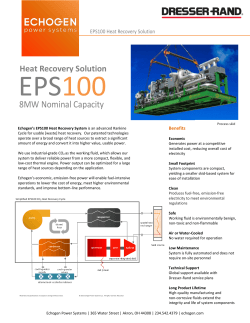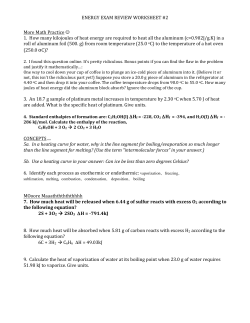
CO2 Flooding - Global Petroleum Show
ENERGY CO2 Flooding Potential Preliminary Assessment of CO2 Flooding Potential for Light Oil Reservoirs Carbon dioxide injection is now the leading enhanced oil recovery (EOR) process for light oils. It can recover 15 to 25% of the original oil in place and prolong production by 15 to 30 years. Many small companies are looking seriously at this low-risk, effective technique to complement and eventually replace waterfloods. But how suitable is CO2 flooding for your field? SRC offers Williston Basin companies a fast, cost-effective preliminary assessment of the CO2 flooding potential of their reservoirs. The ongoing CO2 floods at Weyburn and Midale fields in southeast Saskatchewan are proving just how successful the method can be. At Weyburn, for example, EOR operations account for 20,000 barrels per day, or two-thirds of total current production from the field. The technical design of the Weyburn and Midale ventures relied on results from the Saskatchewan Research Council’s CO2 injection research program underway since 1988. SRC continued to provide the necessary follow-up technical expertise to support the projects as they evolved. CONTACT Mars (Peng) Luo Saskatchewan Research Council 129 - 6 Research Drive Regina, SK Canada S4S 7J7 T: 306-787-5652 F: 306-787-8811 E: Luo@src.sk.ca www.src.sk.ca 2/14 SRC's Approach • Our work with various light/medium oil-gas systems makes it possible to tailor CO2 flooding to a range of reservoir pressure requirements and gas compositions. • We developed an effective near-miscible process for reservoirs that can't sustain the relatively high pressures needed for miscible injection. We also understand the effect of contaminants (e.g., N2 ) in the injected gas. • SRC's assessment package comprises three tasks to determine if your property is a realistic candidate for CO2 injection. 1) Phase behaviour (PVT) testing of the reservoir fluid with varying concentrations of CO2 provides needed data on oil viscosity reduction, oil swelling, CO2 solubility, etc. These data support the other tasks and serve as input for any future numerical simulation to predict field performance. 2) Minimum miscibility pressure measurement through rising bubble apparatus (RBA) studies for various oil-solvent systems. The MMP is the key factor in determining if your reservoir is suitable for CO2 injection. An SRC research technologist prepares the light oil coreflood apparatus for a test. 3) Coreflood tests are carried out to assess oil recovery behaviour and potential under different injection strategies and to obtain endpoint relative permeability data for any future numerical simulation. Benefits of Participation You'll receive a rapid, reliable assessment of the suitability of your Williston Basin light/medium oil holdings for CO2 injection. If you decide to implement this proven and effective EOR method, we can assist in future with numerical simulation and further process optimization. Terms of Participation This single-client, confidential project is intended to take four months to complete. Clients will receive a written report five months from the start date, to be agreed upon by the client and SRC. The Saskatchewan Research Council (SRC) offers a broad range of engineering and technical expertise. For a complete list of services, visit www.src.sk.ca our website at www.src.sk.ca
© Copyright 2025













